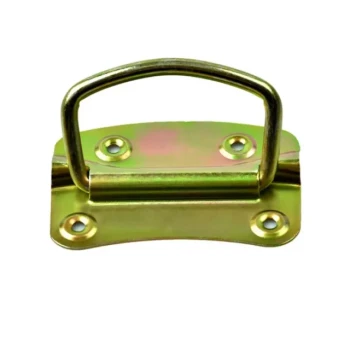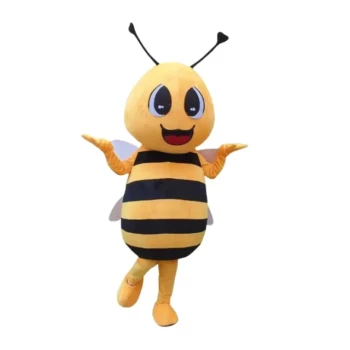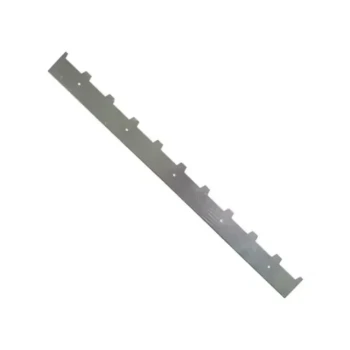In modern beekeeping, the box that houses bees is called a hive, and the most common shape is the rectangular box known as the Langstroth hive. This design consists of a series of stackable, rectangular boxes, each containing removable frames where bees build their honeycomb.
The core concept is not just the rectangular box itself, but the system of modular, stacked boxes with precisely spaced internal frames. This design revolutionized beekeeping by allowing for inspection and honey harvesting without destroying the colony's comb.
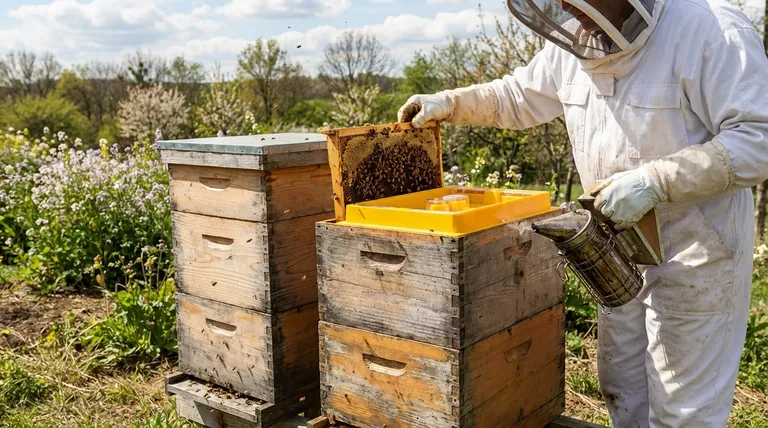
The Anatomy of the Modern Beehive
The Langstroth hive's shape is purely functional, designed for the beekeeper's convenience and the colony's health. It is a system of interchangeable parts, each with a specific purpose.
The Rectangular Box System
The main body of the hive consists of one or more boxes, often called hive bodies or supers.
These boxes are typically made of wood and are built to standardized rectangular dimensions, allowing them to be stacked securely on top of one another.
The Critical Internal Component: The Frame
Inside each box hang several vertical frames. These are the structures that give the Langstroth hive its true purpose.
Each frame is a thin, rectangular structure, made of wood or plastic, that holds a sheet of foundation.
The bees use this foundation as a guide to build their wax honeycomb neatly within the confines of the frame.
The Genius of "Bee Space"
The rectangular shape of the boxes and frames works because of a key discovery known as "bee space."
This is a precise gap (about 3/8 of an inch) that beekeepers leave between the frames and between the frames and the hive walls.
Bees will not build comb in this gap, nor will they seal it with propolis (a resinous glue). This allows beekeepers to easily remove and inspect each frame without damaging the hive structure.
Understanding the Trade-offs
While the rectangular Langstroth hive is overwhelmingly popular, it's essential to understand it is one of several designs, each with different philosophies and goals.
The Focus on Production and Management
The Langstroth hive is designed for efficiency and scalability. Its modular, rectangular shape makes it easy to manufacture, move, and manage.
Removing frames allows beekeepers to inspect for disease, check the queen's health, and harvest honey with minimal disruption to the colony.
Alternative Hive Shapes and Philosophies
Other hive types, like the Top-Bar hive (a horizontal trough) or the Warré hive (a smaller, vertical hive), exist.
These designs often prioritize a more "natural" approach to beekeeping, requiring less intervention but typically yielding less honey and being more difficult to inspect for pests and diseases.
The Langstroth's rectangular efficiency makes it the standard for both commercial and hobbyist beekeepers who prioritize colony health management and honey production.
Making the Right Choice for Your Goal
The shape of a beehive is a direct reflection of the beekeeper's goals and management philosophy.
- If your primary focus is honey production and easy management: The modular, rectangular Langstroth hive is the industry standard for its efficiency and scalability.
- If your primary focus is a more natural, less-intrusive approach: You might explore alternative designs like Top-Bar or Warré hives, accepting the trade-offs in ease of inspection and honey yield.
Ultimately, the rectangular shape of the modern beehive is a deliberate engineering choice designed for a successful partnership between the beekeeper and the bees.
Summary Table:
| Hive Type | Shape | Primary Use | Key Feature |
|---|---|---|---|
| Langstroth Hive | Rectangular Boxes | Commercial & Hobbyist Beekeeping | Modular, stackable frames for easy inspection and honey harvesting |
| Top-Bar Hive | Horizontal Trough | Natural/Low-Intervention Beekeeping | Less intrusive, but lower honey yield and harder to inspect |
| Warré Hive | Smaller Vertical Box | Natural/Low-Intervention Beekeeping | Mimics a natural tree cavity, minimal management required |
Ready to build or scale your apiary with the industry-standard Langstroth hive?
HONESTBEE supplies commercial apiaries and beekeeping equipment distributors with high-quality, durable Langstroth hive components and beekeeping supplies through our wholesale-focused operations. We provide the reliable equipment you need for efficient hive management and maximum honey production.
Contact HONESTBEE today for wholesale pricing and to discuss your specific equipment needs.
Visual Guide
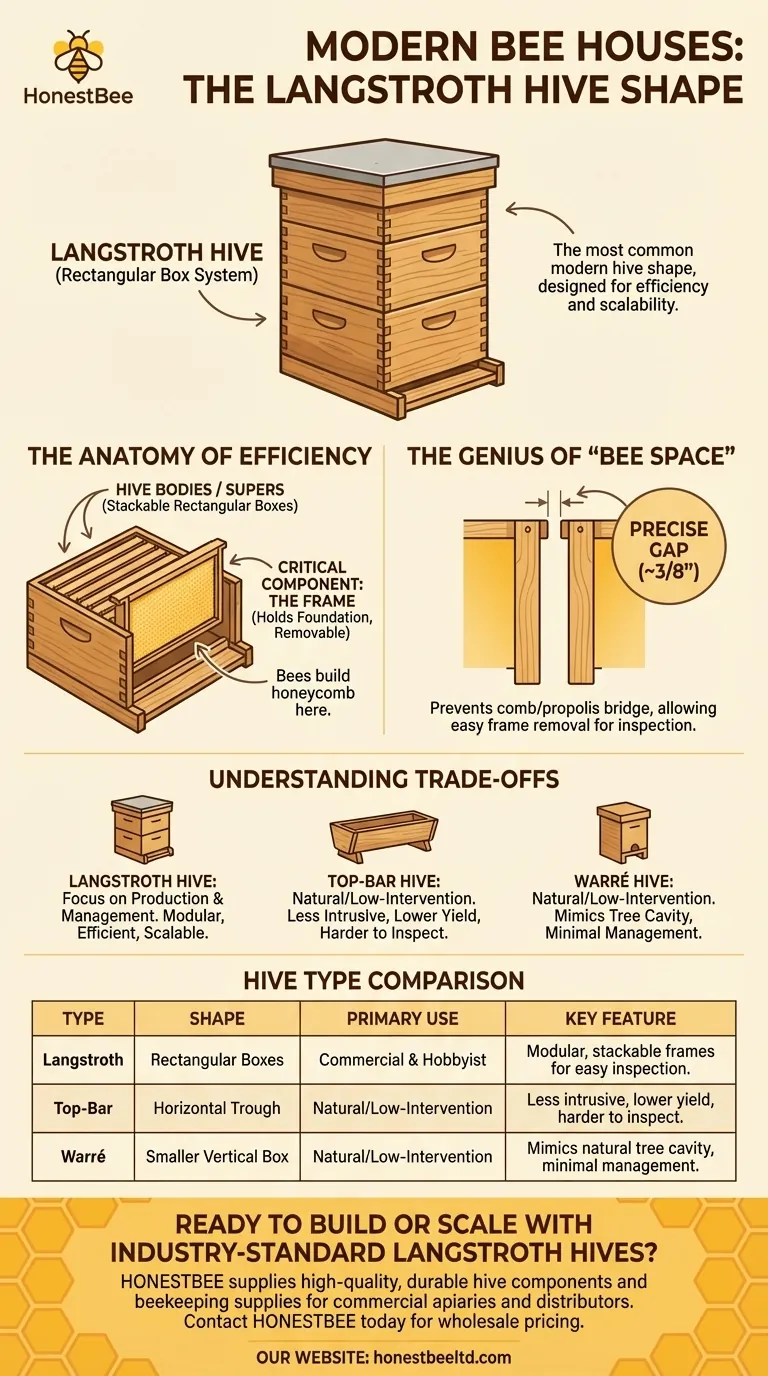
Related Products
- Professional Hive Top Bee Feeder for Beekeeping
- HONESTBEE Professional Long Handled Hive Tool with Precision Cutting Blade
- Telescopic Beehive Outer Cover Lid Roof with Galvanised Sheeting for Langstroth Hive and Beehive Outer Cover
- HONESTBEE Professional Hive Top Bee Feeder Feeding Solution
- Professional Galvanized Hive Strap with Secure Locking Buckle for Beekeeping
People Also Ask
- What types of hive boxes is the round hive top feeder compatible with? Universal Fit for 8 & 10-Frame Langstroth Hives
- What are the advantages of hive top feeders? Maximize Feeding Efficiency for Your Apiary
- Why is a top feeder essential for bees? Ensure Colony Health and Efficiency
- What are the advantages of using top feeders for bees? Maximize Feeding Efficiency & Colony Safety
- What is the best bee feeder for a hive? Choose the Right Feeder for Your Apiary's Scale








